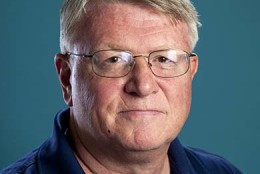On DoD
-
The Art League is hosting an exhibit of artwork created by a soldier recovering from a traumatic brain injury.
July 24, 2015 -
DoD’s investigation found one facility in Utah sent Anthrax to public and private labs in 20 states and seven countries over the last 10 years, and identified major inconsistencies in DoD’s handling of bioweapons. Military leaders ordered a new investigation of Army facility where the deadline bioagent originated from.
July 24, 2015 -
The Defense Department wants to change some of its personnel policies for the first time in decades. Acting Undersecretary of Defense for Personnel and Readiness Brad Carson is working on series of recommendations as part of the Pentagon's Force of the Future initiative. Those recommendations are due to Defense Secretary Ash Carter by Aug. 19. Ron Sanders is the vice president of Booz Allen Hamilton and former chief human capital officer for the Office of the Director for National Intelligence. He tells In Depth with Francis Rose about a war gaming exercise he participated in and what the future of the defense workforce might look like.
July 23, 2015 -
The military lacks the resources it needs for nearly every one of its forces. The Marines are running with two-thirds of the number of battalions it has needed in the past to meet its daily operational needs. The Army is losing 40,000 active duty troops in the next two years. And advanced missile defense programs are underfunded and behind schedule. Michaela Dodge is a senior analyst for defense and strategic policy at the Heritage Foundation. She tells In Depth with Francis Rose that DoD and the next administration are in desperate need of a new nuclear game plan.
July 22, 2015 -
Lockheed Martin plans to sell its IT business and acquire helicopter-maker Sikorsky for $9 billion. It's a deal with far-reaching consequences — not just for Lockheed and Sikorsky parent United Technology, but also for the broader defense industrial base. Jesse Holler is a quantitative analyst at Bloomberg Government. He joined Tom Temin on the Federal Drive with more analysis on this deal.
July 22, 2015 -
Gen. Mark Milley said at his confirmation hearing to become the new Army chief of staff that his service still could meet the demand signal for Army forces, despite recent budget cuts. That could change, though, if demands continue to increase and if budgets continue to decrease.
July 22, 2015 -
The nominee to be the new Army Chief of Staff -- General Mark Milley -- says he believes the troop cutting plans the Army finalized this month will leave a force that’s still capable of doing all it’s being asked to. But that capability also comes with a high level of risk -- including the risk of more casualties in combat. More from Federal News Radio’s DoD reporter Jared Serbu.
July 21, 2015 -
The Army wants to upgrade its Bradley fighting vehicles with some new vision technology. Specifically, a camera that lets disembarking soldiers get a 360-degree view of the battlefield before they exit the vehicle. Maj. Stephen Tegge is a special project officer at the U.S. Army's Tank Automotive Research Development and Engineering Center. He joined Tom Temin on the Federal Drive with more on the project.
July 20, 2015 -
This weekend, the US and Australian militaries will wrap up a huge, biennial training exercise called Operation Talisman Sabre. It's been going on since July 4th, involving a fight between 30,000 Australian and US military personnel and a fictitious enemy. Lt. Gen. Stephen Lanza is the commander of the US Army's I Corps. In a phone interview from Australia, he tells In Depth guest host Jared Serbu that the exercise gave the military a chance to bring a whole-of-government approach to combat and stabilizaiton operations: something he says the Australians happen to be particularly good at.
July 17, 2015 -
With a nuclear deal kind of, sort of in place, Iran has been at the forefront of the news lately. But it would be a mistake to take the focus off other places on the radar screen. In particular, China. Peter Singer is a military expert and futurist at the New America Foundation. He joined Tom Temin on the Federal Drive to explain why he believes the Chinese threat is the primary one the United States faces.
July 17, 2015 -
The Army has known for a few years now its active duty end strength will have to get smaller. It's even announced the final number: 450,000. And sequestration — if it continues in fiscal 2016 — will make things worse, putting the Army on a path to an active duty force of 420,000. But the decisions on which bases those cuts will come from are now out, and many lawmakers are suddenly up in arms. Mark Cancian is a senior adviser for the International Security Program at the Center for Strategic and International Studies and former chief of the Force and Structure and Investment Division at the Office of Management and Budget. He tells In Depth guest host Jared Serbu the Army is taking the same approach to impending budget cuts as a private company might when its workforce gets too expensive.
July 15, 2015 -
We've known for several years that the Army was planning to reduce its active duty end strength from 490,000 soldiers to 450,000. Now we know exactly where those cuts will come from. While the Army says more than 30 bases will be impacted, some will be hit especially hard — Fort Benning, Georgia and Fort Hood, Texas will each lose more than 3,000 soldiers. Joint Base Elmendorf-Richardson in Alaska will lose 2,600. Retired Lt. Gen. Guy Swan is the vice president for education at the Association of the U.S. Army. He tells In Depth guest host Jared Serbu what the cuts mean for soldiers and military communities.
July 14, 2015 -
The U.S. Army wants to know how it compares to its allies and enemies so it can determine which of its fielded systems are performing comparatively well and what needs to get better. To conduct that analysis, leaders turned to the RAND corporation, which had the challenge of assessing the world's armies based entirely on open-source information — and distilling it all into a detailed, but unclassified report. John Gordon is a senior policy analyst at RAND, and one of the authors of that report: Comparing U.S. Army Systems with Foreign Counterparts. He tells In Depth guest host Jared Serbu, what the study found, and what the Army wants to get out of it.
July 14, 2015 -
Geographic information systems and intelligence have been converging for a while now. Now nearly all forms of information are available in digital form. The challenge is integrating them. That discipline is called GEO-INT. Former Coast Guard Commandant Thad Allen is now an executive vice president at Booz Allen Hamilton. As a long-time user of both geographic information and intelligence, he joined Tom Temin on the Federal Drive how this data convergence is changing the intelligence landscape and even his own company.
July 10, 2015 -
When is a subcontractor not a subcontractor? Answer: When the prime is so dependent on the sub that, in effect, the sub really is the prime. But it's not always easy to tell. That's the gist of a recent case involving an Army services contract. In this week's Legal Loop, Joe Petrillo, a partner at the law firm Petrillo and Powell, joined the Federal Drive with Tom Temin with more.
July 09, 2015














